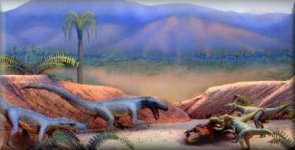
MODULE 12: Dinosaurs
Objectives: In this module you will learn about the life and times of the very successful Dinosaurs ("terrible lizards"), that dominated the earth for over 150 million years. We will examine their rise and diversification, aspects of their ecology, as well as the mass extinction event that killed off all of their lineages with the exception of the birds.
Background: In the Fossil Groups Module you learned how the dinosaurs were classified into 2 major groups based on their hip anatomy. But where and when did these 2 groups of dinosaurs, the saurischians and ornithiscians, originate?
Related Groups: In order to understand the evolutionary history of the dinosaurs we need to back-up a bit in time and examine two other vertebrate groups, the diapsids the archosaurs. The diapsids are those members of the tetrapods (four-legged vertebrates) that have two fenestrae (holes) near the temple region of their skulls. The skull holes of the diapsids are considered to represent places for jaw musculature (Tell me more about skull holes and tetrapod classification). The development of better organized chewing was an important development within the group. The diapsids were and are currently very successful and include all of the modern reptiles except turtles, which are anapsids and have no fenestrae. The diapsids produced the archosaurs that include the dinosaurs (including birds), crocodiles, and pterosaurs (an extinct flying reptile group).
Early Dinosaurs: Richard Owen (1842) coined the term dinosaur ("terrible-lizard") for large fossil reptile bones that had been known in Europe since the 1820's. They are a group of reptiles characterized by their upright postures, some of which represent the largest land animals that ever lived. Our first records of dinosaurs come from the Triassic over 230 million years ago (Example: Gertie from the Petrified Forest, U.S.A) . In some ways they had the appearance of walking crocodilians. (See picture below from the Field Museum). The early forms had snout to tail lengths of over 10 feet.

They are represented by fossil skeletons, skin, blood (?), footprints, nests/eggs, and coprolites (feces)..The discernible fossil record of Dinosaurs begins over 225 million years ago and continues until 66 million years ago when all of the remaining large dinosaurs perish from the earth. In comparison to the dinosaurs, that flourished for over 150 million years, mammals have been the dominant land animal group for only the last 66 million years. The story of Dinosaurs is truly described as one of success, especially considering the continuing success of their living representatives, the birds. You should explore in detail the UCMP website summarizing dinosaur systematics (evolutionary relationships, shapes, and sizes) and dinosaur lifestyles.
Dinosaur Extinction: In recent years, scientists have gathered a large body of data that suggests the dinosaurs perished as a result of an extraterrestrial strike on the earth by a meteorite. Current data indicates that the meteorite struck in the Yucatan peninsula creating the Chicxulub crater. Following the meteorite strike the atmosphere became clouded in dust and this in turn caused dramatic cooling and widespread ecological collapse. All dinosaurs but the birds perished at this time known as the K-T boundary (Cretaceous-Tertiary Boundary 66ma).